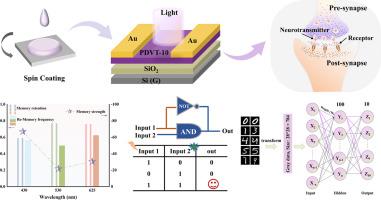High-performance organic synaptic transistors for multi-wavelength perception simulation and neuromorphic computing
IF 7.4
引用次数: 0
Abstract
Inspired by biological neuromorphic systems, biomimetic artificial synaptic devices based on organic transistors have become a prominent research direction. The polymer PDVT-10, which is commonly used as channel layer in devices, has excellent stability and high mobility. However, previous research in simulating photonic synapses has focused on doping and hybrid structures, which is limited by the choice of materials and complex fabrication processes in exploring the multifunctional applications of photonic synaptic devices in the future. Here, we successfully constructed individual PDVT-10 photoelectric synaptic devices to simulate biological synaptic plasticity under different wavelengths of light pulse stimulation for the first time. Furthermore, the application of light-induced high-pass filtering characteristics, pain sensing, sensitization, as well as memory functions were realized. In addition, the application of logic circuits was realized based on the photoelectric synergistic effect. Moreover, the introduction of a polyvinyl alcohol light-absorbing layer endowed the device with light potentiation and electrical depression function. Subsequently, a simple convolutional neural network was successfully constructed and implemented for the MNIST number recognition task. This work not only contributes to an in-depth understanding of the response mechanism of the device to different wavelengths of light, but also enriches the application areas of the device and provides important support for the practical applications of neuromorphic computing in the future.

用于多波长感知模拟和神经形态计算的高性能有机突触晶体管
受生物神经形态系统的启发,基于有机晶体管的仿生人工突触装置已成为一个突出的研究方向。聚合物PDVT-10具有优异的稳定性和高迁移率,是器件中常用的通道层。然而,以往的模拟光子突触的研究主要集中在掺杂和杂化结构上,在探索光子突触器件的多功能应用时,受到材料选择和复杂制造工艺的限制。本研究首次成功构建了单个PDVT-10光电突触器件,模拟了不同波长光脉冲刺激下的生物突触可塑性。此外,还实现了光诱导高通滤波特性、痛觉、敏化和记忆功能的应用。此外,基于光电协同效应实现了逻辑电路的应用。此外,聚乙烯醇吸光层的引入使该器件具有光增强和电抑制功能。随后,成功构建并实现了一个简单的卷积神经网络,用于MNIST数字识别任务。这项工作不仅有助于深入了解该器件对不同波长光的响应机制,而且丰富了该器件的应用领域,为未来神经形态计算的实际应用提供了重要支持。
本文章由计算机程序翻译,如有差异,请以英文原文为准。
求助全文
约1分钟内获得全文
求助全文

 求助内容:
求助内容: 应助结果提醒方式:
应助结果提醒方式:


